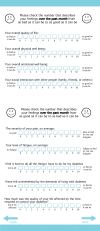A brief Patient-Reported Outcomes Quality of Life (PROQOL) instrument to improve patient care
- PMID: 24265598
- PMCID: PMC3825652
- DOI: 10.1371/journal.pmed.1001548
A brief Patient-Reported Outcomes Quality of Life (PROQOL) instrument to improve patient care
Abstract
Jeff Sloan and colleagues describe the development of the Patient-Reported Outcomes Quality of Life (PROQOL) instrument, which captures and stores patient-recorded outcomes in the medical record for patients with diabetes. Please see later in the article for the Editors' Summary.
Conflict of interest statement
The authors have declared that no competing interests exist.
Figures



References
-
- Marshall S, Haywood K, Fitzpatrick R (2006) Impact of patient-reported outcome measures on routine practice: a structured review. J Eval Clin Pract 12: 559–568. - PubMed
-
- Greenhalgh J (2009) The applications of PROs in clinical practice: what are they, do they work, and why? Qual Life Res 18: 115–123. - PubMed
-
- Rose M, Bezjak A (2009) Logistics of collecting patient-reported outcomes (PROs) in clinical practice: an overview and practical examples. Qual Life Res 18: 125–136. - PubMed
-
- Gabriel SE, Normand SLT (2012) Getting the methods right - the foundation of patient-centered outcomes research. N Engl J Med 367: 787–790. - PubMed
-
- Detmar SB, Muller MJ, Schornagel JH, Wever LD, Aaronson NK (2002) Health-related quality-of-life assessments and patient-physician communication: a randomized controlled trial. JAMA 288: 3027–3034. - PubMed
Publication types
MeSH terms
Grants and funding
LinkOut - more resources
Full Text Sources
Other Literature Sources
Medical

